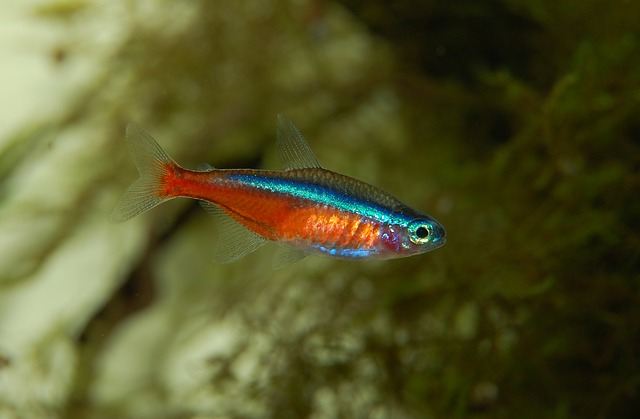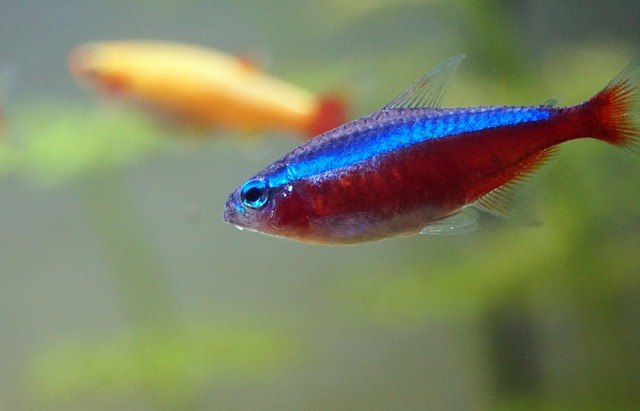Neon tetras are an aquarium owner’s favorite. They come in a wide array of vibrant colors and are a great addition to any freshwater tank. They are also very hardy fish, unfussy, and don’t require extensive care.
Their adaptive nature allows them to flourish in many types of aquarium set-ups. That is why they make them a great choice for people who are just starting out in the fish-keeping hobby.
Because of their high demand, neon tetra breeding is a good business to jump into. Especially for those who already have a lot of experience caring for neon tetras, breeding may not be too much of a learning curve.
Contents
How to Breed Neon Tetras
Understanding how neon tetras breed in the wild can help you reach the ideal conditions for your tank. However, you may find yourself asking, “How do neon tetras breed?”
In the right conditions, a female will lay her eggs and the male will then fertilize them.
Aside from needing the right environmental conditions, adult tetras (tetras at least twelve weeks old) will breed during the early morning. Therefore, adults should be transferred to the tank in complete darkness, preferably at night.
Remember to separate the couples that you have determined for breeding, so as to ensure that the ideal breeding conditions are met, without disturbing other fish.
Ideal Conditions for Neon Tetra Breeding
When it comes to fish breeding, the conditions of the tank will determine whether attempts will be successful or not.
There are many conditions that you will have to achieve and maintain in your breeding tank, so as to ensure that your tetras spawn.
These conditions include the number of fish in your tank, the water (amount, mineral content, pH, and temperature), and the amount of light.
Number of Fish
When breeding, try to keep no more than five pairs in one tank. It would be better to use a smaller tank, especially if you do not have prior experience, to ensure that you can control all the conditions in this tank.
If you have one couple, a ten-liter capacity will be enough; a twenty-liter tank will be necessary for more than one couple.
Mineral Content
When filling up the water in your tank, make sure that you have the right mineral content. For breeding tanks, a low-mineral content (about 1-2 dGH) is necessary.
This can be achieved by mixing tap water and reverse osmosis water one part to three parts, respectively.
You can also use rainwater to get the correct amount of mineral content, although this method may not be the most accurate.
pH
The pH of the water should be slightly acidic, at 5 or 6 pH. Make sure to regularly check for the pH of your tank using specially designed strips, which can be found in most fish supply stores.
Remember to check the pH of your tank regularly, as any additions could cause the pH of your tank to change.
Neon Tetra Temperature
The ideal neon tetra temperature for breeding should be kept a bit below room temperature, specifically at 77 degrees Fahrenheit. Any warmer and your tetras will fail to inseminate.
To ensure that you have the right temperature, a thermometer may be necessary. Remember to regularly measure the temperature of your tank, as this will fluctuate as well.
Light
Aside from the mineral content, pH, and temperature, the most important thing you will need to maintain is the amount of light – or rather, the lack of it.
Make sure to cover your tank to make sure that it is kept dark, and keep it in a dim corner or room. The lack of light has been attributed to the difference between a successful and unsuccessful breeding attempt.
Neon Tetra Breeding
Once you have achieved the right conditions for your breeding tanks, you can now introduce adult tetras. They must be at least twelve weeks old to be viable for breeding.
You can keep the adult tetras in the breeding tank for one to two weeks. In this time, remember to care for your adults as you would all your other fish. It would be best, however, to feed your pregnant neon tetra live feed.
Neon tetra eggs may be hard to spot, as they will be small and translucent. If you don’t see eggs within two weeks, it would be best to adjust the conditions in your tank.
Fish eggs can be hard to see, however, as they are translucent. If you don’t notice them, make sure to check your plants and gravel.
Once you notice eggs, remember to remove the adult tetras immediately. Otherwise, they may eat the eggs. Fish eggs will hatch in about a day or two.
Caring for Tetra Fry
You will notice larva appearing after about five days, and they will begin to swim after three more days. They will be small, hard to identify, and will often look like small shards of glass.
Remember to keep your new tetras in the dark for about a week after they hatch.
No matter how well you try to care for your juveniles, there will be some who do not survive, as they are more sensitive to illnesses and injury.
However, here are some things you can do to tip the odds to your favor. First, make sure that all harmful objects are removed from your tank, especially filters.
Second, feed your juveniles fish food made specifically to sustain fry. After a few days, you can feed your juveniles small live feed, like baby brine shrimp.
Lastly, ensure that your tank is kept clean and free from diseases.
As they grow, gradually adjust the environment of your tank to match the one in your main tank. You can transfer your tetras once they reach maturity at twelve weeks.
Here’s a video showing more information neon tetra breeding.
Do you have any tips on breeding neon tetra?





how do you condision the neon tetras to breed what foods